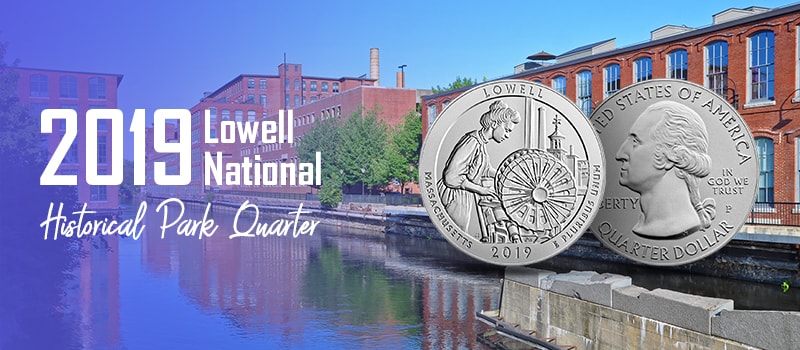2019 Lowell National Historical Park quarter

The 2019 America the Beautiful quarters mark the 10th year since the inception of the program in 2010. This year the U.S. mint has come up with some great designs for the next 5 quarters for Lowell National Historical Park in Massachusetts, American Memorial Park in Northern Mariana Islands, War in the Pacific National Historical Park in Guam, San Antonio Missions National Historical Park in Texas and Frank Church River of No Return Wilderness in Idaho. This post looks at the “Lowell National Historical Park quarter” and its history.
East Chelmsford or Lowell as it was later named was to be the salvation for many immigrants who landed in the shores of America in the 1800s. It also became hell for the very same immigrants because of its appalling working conditions in the mills there. The Lowell National Historical Park quarter released as the 1st of the five ATB quarters this year honors “Lowell” the mill town in Massachusetts that changed the lives of many.
Lowell National Historical Park in Massachusetts
Massachusetts was the promised land for many lives escaping from religious persecution like the first Pilgrims. Millions of immigrants from Europe yearning for a better life walked in the footsteps of the forefathers in the next three centuries and reached Plymouth colony. With ready labor coming every other day, Lowell in Massachusetts soon came to be known as the ‘cradle of American Industrial revolution’.
Francis Cabot Lowell, the man after whom Lowell was named was a Harvard alumnus. He was primarily engaged in trading and shipping. He owned eight merchant ships that traded in cotton, silk, tea and molasses. Though US gained independence, Lowell felt it was still dependent on Europe for finished goods. He felt that unless US started manufacturing goods on its own it may never attain a position of importance in the world market. He became interested in the textile mills of Europe. Lowell visited the English and Scottish mills in a bid to find out the mechanism of the looms. As the English were quite secretive about the working of the spinning and weaving machines, he couldn’t get their models. What Lowell did to circumvent this bit of a problem would astonish the coming generations. He memorized the mechanism and didn’t commit it to paper.
Once back in the US he enlisted the help of his brothers-in-law and like-minded merchants to establish the Boston Manufacturing Company (BMC) in Waltham, Massachusetts that used the Charles River for running a complete textile mill. Based on the success of the BMC another mill was built on the Merrimack River. This new mill town in East Chelmsford was renamed “Lowell” after the pioneer’s death just 3 years after his first mill.
More mills were constructed in the Massachusetts area based on the “Waltham-Lowell” system of power looms and then later spread to the entire country. In the 1900’s, because of economic downturn and two world wars the mills in Massachusetts became run down. By 1960’s the last mill was shut down.
In 1978, Lowell was accorded the National Historic Park status. Though the Massachusetts mills were known for the inhuman conditions in which people worked, they are considered a symbol of the pioneering spirit of America. The mills were a precursor to the modern mills that persevere to this day.
2019 Lowell National Historical Park quarter
This year the Lowell National Historical Park quarter was released on February 4th . It was designed by Joel Iskowitz and sculpted by Phebe Hemphill. The design depicts a woman working at a power loom with its prominent circular bobbin battery. A view of Lowell, including the Boott Mill clock tower, is seen through the window. Inscriptions are “LOWELL,” “MASSACHUSETTS,” “2019,” and “E PLURIBUS UNUM.”
This entry was posted in General and tagged historic bills and notes, atb quarters, america the beautiful quarters on May 24, 2019 by lavanya kannan

Leave a comment